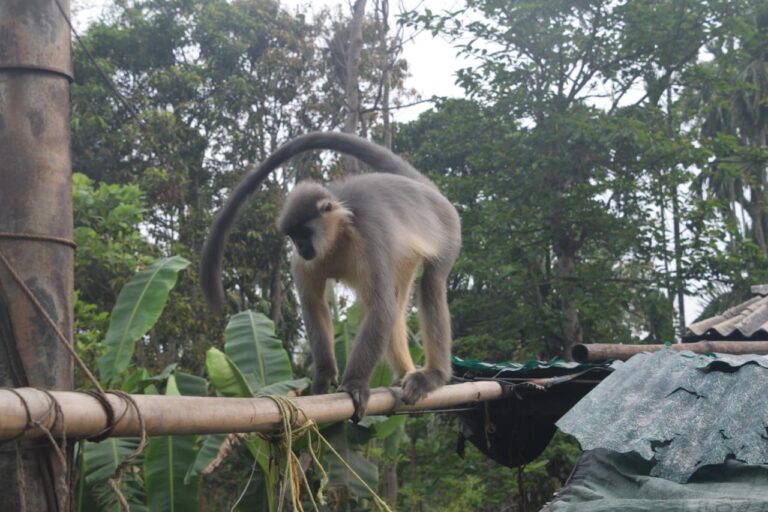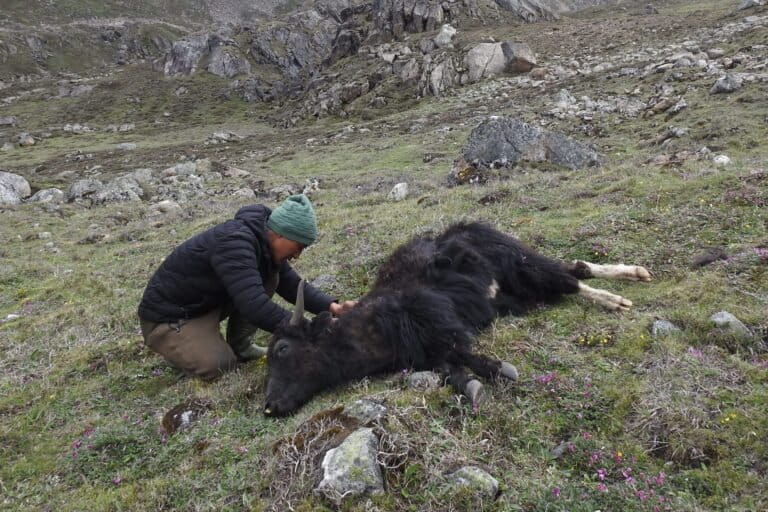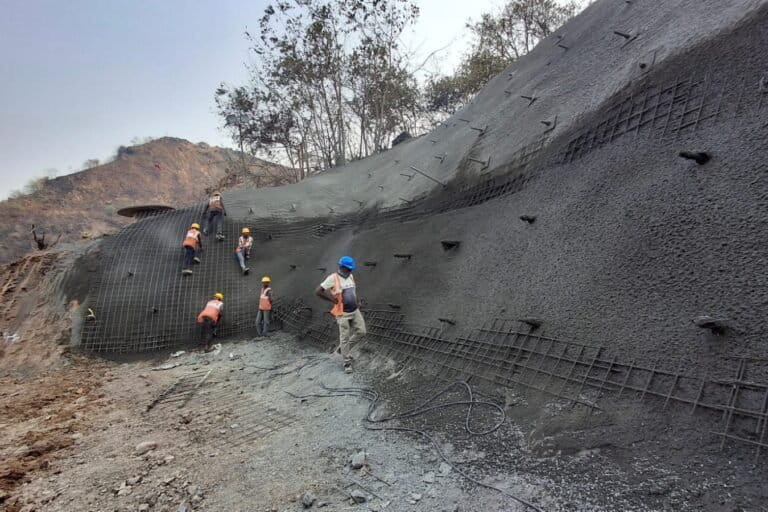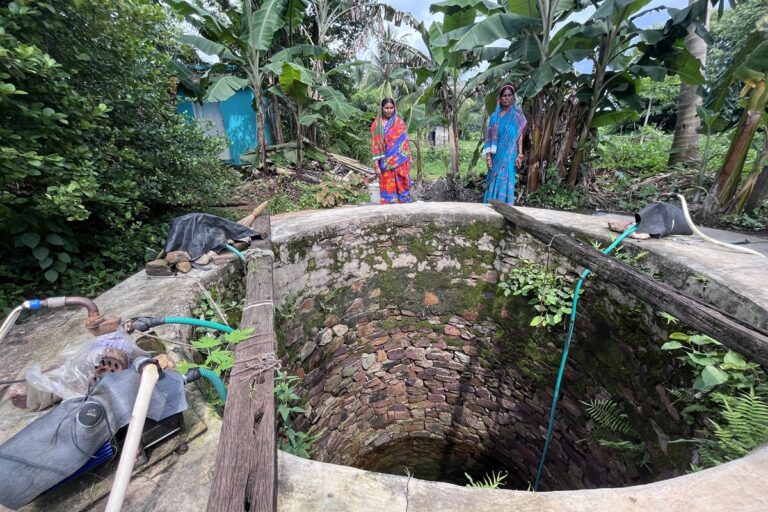- Researchers have described a new species of cicada, the Becquartina bicolor, from South Garo Hills and Ri Bhoi districts in Meghalaya.
- Becquartina bicolor, commonly known as the bicolor butterfly cicada, is the first cicada of the Becquartina genus to be reported from India. It appears every year in the summer season in Meghalaya.
- The indigenous Garo community is already familiar with the bicolor butterfly cicada, highlighting the need to acknowledge and explore the traditional ecological knowledge.
On a summer afternoon in 2017, field entomologist Vivek Sarkar and his field assistant Tushar Sangma, struggled to manoeuvre their motorbike on a dirt track as the mud squelched beneath the tires. They were in the Balpakram National Park in South Garo Hills, Meghalaya, to study cicadas, as a part of Sarkar’s Ph.D. fieldwork at the time. Once inside the forest, Sarkar unpacked an audio recorder plugged into what looked like a small translucent white TV dish, known as a parabolic microphone. He was ready to do an acoustic survey, listening closely to the buzzing of the cicadas. Soon, he heard a call that sounded unlike any of the cicada calls he had heard before.
“Using binoculars and a laser rangefinder, I looked up and saw a cicada perched on the canopy of a tree, 30 metres above the ground,” said Sarkar. While he was observing the cicada, the sun began to set. A bat swooped down and grabbed the cicada. As the cicada struggled to free itself from the bat’s grasp, it fell onto the ground, right in front of Sarkar. The entomologist hurriedly photographed the insect as it crawled upon a leaf. This was how he chanced upon the bicolor butterfly cicada (Becquartina bicolor), which, unlike most cicadas with shimmery, sheer wings, has opaque, leathery and patterned wings, much like a butterfly.

The thumb-sized bicolor butterfly cicada has brownish wings with saffron markings and white patches on them. It is a slow flier and in the Balpakram plateau in South Garo Hills, Sarkar noticed that wandering cicadas looked still in their flight and got carried far away with the wind.
This cicada appears during the summer in May and June in Meghalaya. It makes an initial short and loud cackle, which is followed by a much softer and drawn-out sound.
The Becquartina or butterfly cicada genus has been previously reported from Thailand, Vietnam and China. There is no record of this species from India’s neighbouring countries Nepal, Bhutan, Bangladesh, Myanmar and Sri Lanka.
Sarkar said that this new discovery in India is akin to collecting a stamp size picture, one that will contribute to a bigger collage of the cicadas of India in the coming decade. Since this discovery in 2017, Sarkar visited Balpakram every year to observe this cicada species, until the COVID-19 lockdown brought his work to a halt.
Twice discovered, far apart
In May 2020, unaware of Sarkar’s discovery, another scientist in Ri Bhoi district, about 150 kilometres away from South Garo Hills, stumbled upon the bicolor butterfly cicada. Rodeson Thangkhiew, who is presently an assistant professor of zoology at the University of Science and Technology in Meghalaya, was a Ph.D. scholar studying cicadas in the state at the time. He, along with a friend, had gone foraging for wild edible plants in a community forest, which used to be a sacred forest of the Bhoi community in the past. Thangkhiew was drawn by the unique call of a cicada coming from a tree next to a small stream. After he saw a couple of cicadas flying, he collected a specimen. He excitedly reached out to S.R. Hajong, who teaches zoology at the North Eastern Hill University (NEHU) in Meghalaya.
During extensive field trips between 2020 and 2022, the duo studied the call and behaviour of the species. Hajong, who has been studying cicadas in the northeast for 15 years now, was the first one to describe Chremistica ribhoi, the only periodic cicada from India and Playtomia kohimaensis, a species of cicada from Nagaland. He and Thangkhiew were also the first ones to report the Salvazana mirabilis mirabilis cicada from Ri Bhoi in 2016.

The scientists published their findings in a paper in March 2024 in Zootaxa. In the paper, Sarkar (who now works as a senior project associate at Wildlife Institute of India), Thangkhiew, Hajong and others, describe how they found the bicolor butterfly cicada in South Garo Hills and Ri Bhoi. This species has not been sighted anywhere between these areas, or elsewhere.
In both the discoveries in South Garo Hills and Ri Bhoi, the scientists located the cicada through its call and collected specimens. They also photographed and filmed the cicadas and recorded their calls. “Some of them were high up on the branches. We used long bamboo poles with natural adhesive made by the locals using resin from tree sap [to collect them],” said Hajong. The scientists processed the audio recordings through a software that helped create a profile of the cicada’s calls, detailing the frequency, wavelength and amplitude of its sound.
An audio recording of the call of the bicolor butterfly cicada in May 2021, from a community forest in Ri Bhoi district in Meghalaya. Audio by S.R. Hajong.
Sarkar also faced some challenges in identifying the species because of limited research on it. Papers describing the Becquartina genus were mostly in French or Mandarin, based on the language of the scientists who have described them so far, and not available in English, which made it difficult for him to get the descriptions. Further, the disruption caused by the pandemic also slowed down the work and prolonged the publishing of the discovery.
An overview of cicadas across Asia
There has been a sharp decline in global insect populations over the last few decades. Insects play an important role in the ecosystem, agriculture and human health. “Cicadas are found almost throughout the globe except the Arctic regions and deserts and have been studied widely in North America. The total number of species of cicadas in India described till date is 204,” said Sarkar. Cicadas are also considered harbingers of the summer and monsoon in the U.S. and India. All cicada species in India, except one, emerge annually.
“It is a very significant discovery in cicada taxonomy. It is the first time this genus has been discovered in India,” said Hajong.
Despite scientists discovering new species of cicadas in the Western Ghats and northeast India in recent years, these insects still remain understudied. In 2016, scientists from the National Centre for Biological Sciences (NCBS), Bengaluru, prepared a checklist of 281 cicada species from India, Bangladesh, Bhutan, Myanmar, Nepal and Sri Lanka.
The northeast is considered the geographical gateway for much of flora and fauna in India. “This discovery could help those who study biogeography or zoogeography understand how the migration and distribution of fauna occurred in the Indian mainland through the eastern faunal gateway,” Hajong told Mongabay-India. Cicadas spend the early stages of their life underground and feed on certain host plants. “We do not have any information about any host plants of Indian cicadas which is a major study gap,” said Sarkar.
The future of the bicolor butterfly cicada
Kiran Marathe, who researched butterflies and cicadas at NCBS also reviewed the research paper published in Zootaxa. He called it a “well-done study”. “Such discoveries may also inspire people to identify new study systems for evolutionary and ecological research and the cicadas happen to be one such system whose diversity is not well-explored in India. Discoveries of this kind are a good start,” said Marathe.
Both Sarkar and Hajong feel that the next step is to conduct a long-term biological study to understand the cicada’s mating behaviour, how much time it takes to develop from eggs, finding its host plants and its pattern of distribution. “If we answer these questions, we will be able to understand how these cicadas interact with their habitat and vegetation and how that relates to climatic conditions,” said Hajong.

In Meghalaya, cicadas link the indigenous Garo community to their natural world and influence the community’s agriculture, language, culinary and cultural practices. For instance, farmers in South and West Garo Hills who practise jhum or shifting cultivation believe that the call of the phegol or Dundubia annandalei, which was reported only some years ago, signals a good harvest. The traditional ecological knowledge harboured by indigenous communities in the northeast can provide important lessons that inform sustainable mitigation and adaptation strategies to environmental disturbances.
Both Sarkar and Hajong said that the locals in South Garo Hills and Ri Bhoi were already familiar with the bicolor butterfly cicada as well. “Many of our (cicada) discoveries already have a Garo name,” said Sarkar, who spent time in the villages surrounding the forests when he was studying cicadas in Meghalaya. He recalls playing the audio recordings of the cicadas’ calls for the locals who were able to identify the insect. He emphasises on the need for scientists to acknowledge and explore the traditional ecological knowledge of the local communities. In the coming years, Sarkar and Hajong plan to write a monograph on the cicadas of Meghalaya.
Read more: Mysterious new bioluminescent mushroom glows in the forests of Meghalaya
Banner image: Becquartina bicolor sitting on a leaf in Balpakram National Park in South Garo Hills in Meghalaya. This was the first individual of the species sighted by Sarkar in 2017. The cicada’s wings were damaged when it was caught by a bat. Image by Vivek Sarkar.













